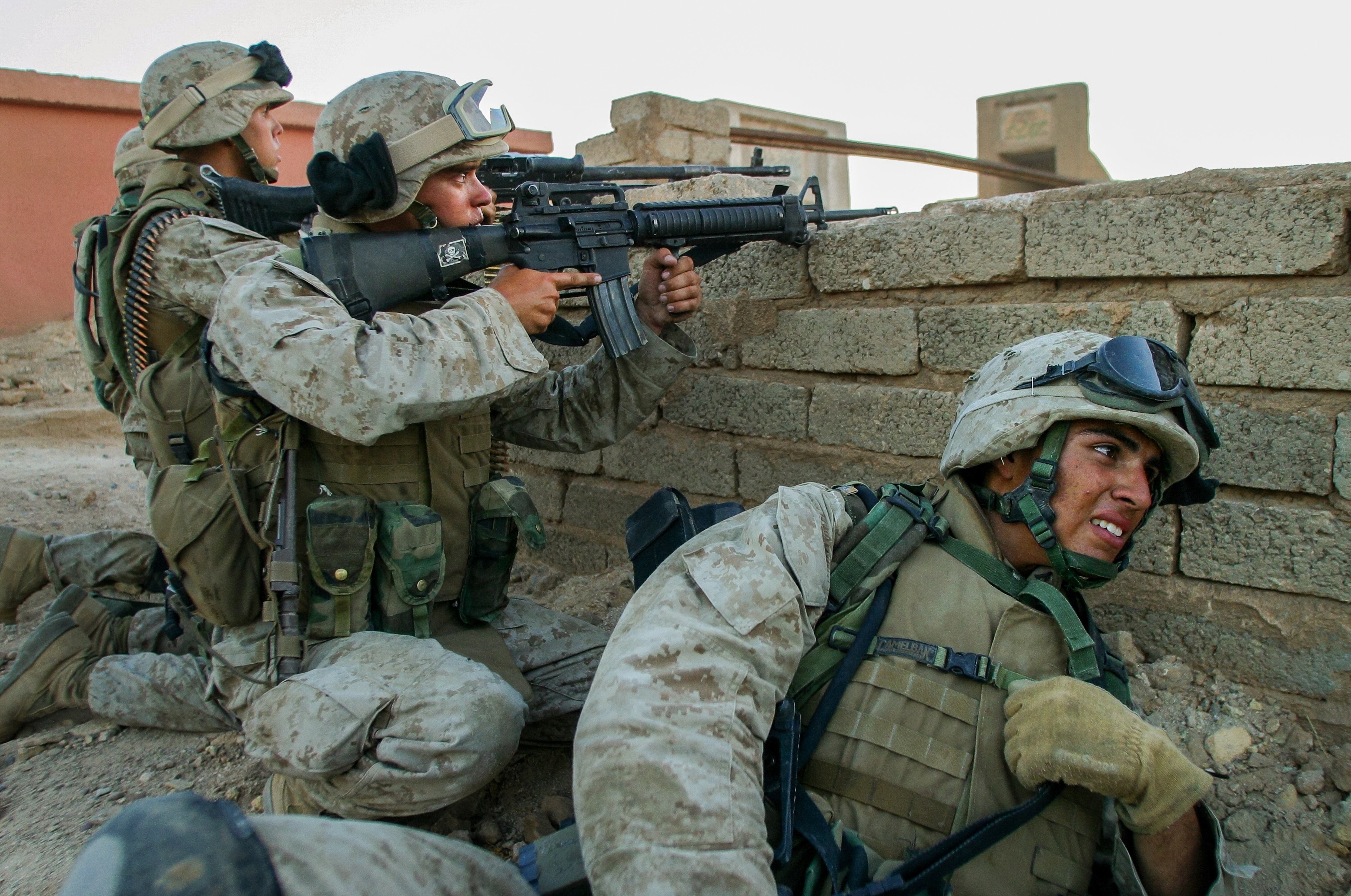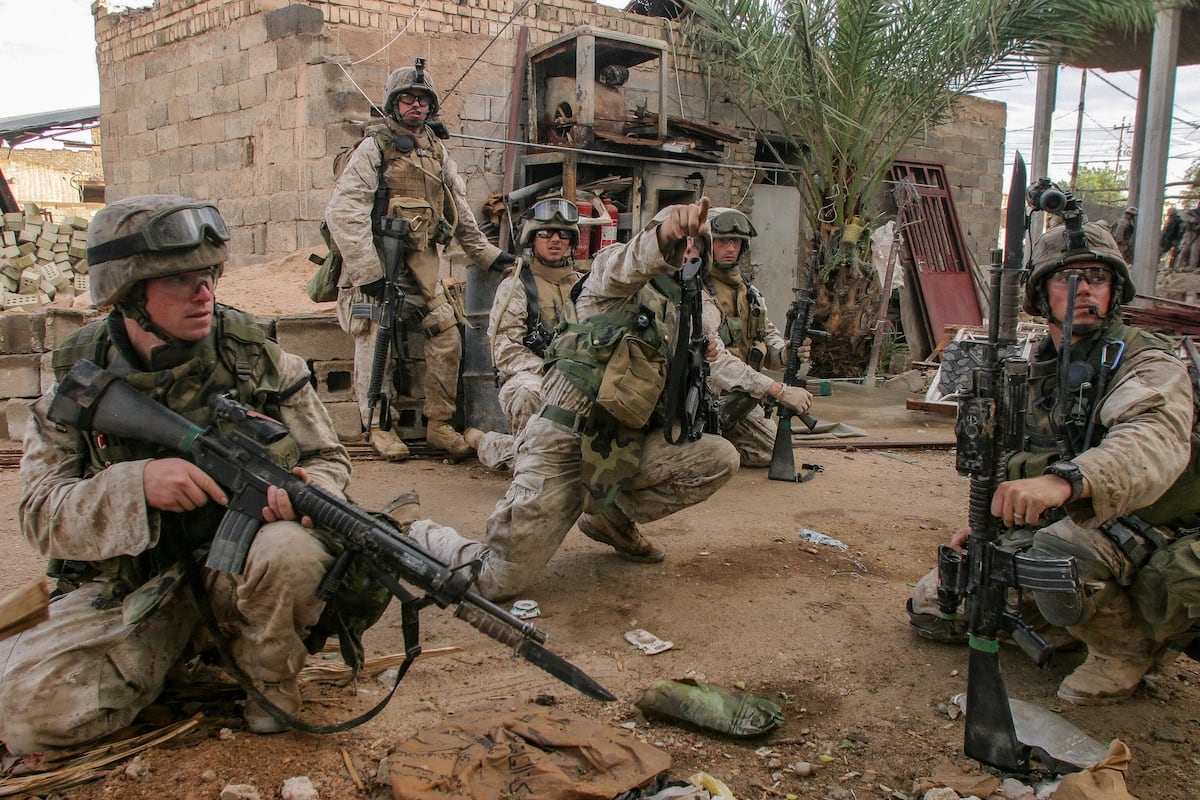Jan Bender remembers the moment as if it were yesterday.
Taking cover from insurgents, his fireteam had just assembled in the dark in front of a house in Fallujah, Iraq, when the Marines were overwhelmed by the percussive blast of an explosion. About 40 yards in front of them was a mass of flames — the fiery remains of an Iraqi vehicle. Just behind them was the smoking barrel of the 120mm cannon from an M1A2 Abrams Main Battle Tank.
In the wee hours of Nov. 8, 2004, the Iraq War became very real for Bender, who was embedded with India Company, 3rd Battalion, 1st Marine Division. With a camera in one hand and a 9mm M9 Beretta pistol in the other, the then-20-year-old combat correspondent was momentarily deafened and disoriented by the roar of the near-simultaneous explosions.
“I had never been on the business end of an Abrams before that close,” he recalled in an interview with Military Times. “We worked with tanks for weeks and weeks after that and came to be kind of numb to it. Just being a few feet behind the barrel is much different than being a few feet in front of it as far as the overpressure and blast go.”
RELATED
That’s the kind of gritty realism on display in the documentary “The Last 600 Meters: The Battles of Najaf and Fallujah,” airing on PBS on Monday, the day before Veterans Day and the 250th anniversary of the U.S. Marine Corps. The film by Michael Pack tells the story of these deadly engagements through the words and emotions of the U.S. troops who survived them.
The film gets its name from a comment made by Master Sgt. Karl R. Erickson, a U.S. Army Special Forces sniper who equates his mission with looking through his scope at a target: “Foreign policy? I don’t make it. I just deliver the last 600 meters of it.”
The rest of the documentary details what that means for the troops on the ground and in the air over these deadly battlefields, chronicling their courage, commitment and camaraderie through a bloody ordeal.
“We conducted the interviews three years after the battles when memories were fresh,” Pack said in an interview. “But it was hard time to get it on the air then. Everyone had their opinions about the war and it was clouded in politics. We strove to tell these stories without politics from the point of view of the people who were there. Maybe now is a good time to look back and remember what happened.”

What happened was some of the heaviest urban combat by the U.S. military since the 1968 Battle of Hue in Vietnam. Engaging scores of insurgent groups in an uprising similar to the Tet Offensive, U.S. forces fought from house-to-house, alley-to-alley and even face-to-face to retake the Iraqi cities of Fallujah and Najaf.
In the film, Jeff Stevenson, then a Marine major, refers to the deadly close-quarters combat as a “three-block war.” Marines and soldiers had to clear each area in succession so enemy fighters would not be able to get behind them.
During the 2003 invasion of Iraq, the U.S. military quickly defeated the armies of Iraqi leader Saddam Hussein. However, the fighting was not over. Insurgents flooded into the country to resist the U.S. takeover. In “The Last 600 Meters,” journalist Thomas E. Ricks described how surprised he was by the situation on the ground:
“Iraq was a much more troubled place than we realized. I remember thinking, ‘I thought this was bad. I hadn’t thought it was going to be this bad.’”
By 2004, insurgents had taken over the two cities. American troops were given the mission of recapturing them. In early August, Army and Marine units pushed into Najaf amid heavy combat. The fiercest fighting took place at the massive Wadi al-Salam cemetery, which features a series of underground tunnels and aboveground monuments — ideal hiding places for ambushes. American forces often resorted to close-quarter combat to clear the seven-square-mile graveyard.
The battle for Najaf ground on throughout the month with heavy losses on both sides. At the center of the city was the Imam Ali Shrine, where enemy fighters had taken refuge. While U.S. Air Force gunships and jets attacked the area around the holy site, Marines and soldiers participated in hand-to-hand fighting to close the gauntlet.
One of the Marines interviewed in the documentary, Lt. Seth Moulton, now a U.S. representative from Massachusetts, was leading a platoon of Marines in the basement of a building when the patrol next to him encountered insurgents. It happened so fast that the Marine on point only had time to react.
“It was so dark and the Marine was clearing this room,” Moulton said in an interview with Military Times. “This guy tried to tackle him and the Marine couldn’t get his gun on him. They got into a ground fight, so the Marine pulled out his bayonet and killed the guy.”
As commandos of the Iraqi security forces prepared to storm the shrine, a negotiated settlement brought an end to the fighting in Najaf. A few months later, U.S. forces moved into Fallujah. In April, a ceasefire was declared, though tensions remained high. On Nov. 7, the attack began anew with American troops pushing the insurgents south through the built-up city to more open terrain.
Bender accompanied India Company into what he called “a sea of violence.” Fallujah was the scene of intense house-to-house fighting against a well-armed and determined enemy.
“There were a number of firefights in open streets, engagements where the asphalt is popcorning around you,” he recalled. “You have absolutely no cover and you are running wide open, trying to return fire. It’s a humbling experience. If you don’t have a relationship with your maker before you get into a situation like that, you will during it.”

One of the most intense moments in “The Last 600 Meters” takes place at “Hell House” in Fallujah. Marines had entered the structure and were shot by insurgents from the second floor. Teams attempted to rescue the men, each in turn being pinned down by machine gun fire and grenades. Trapped, there seemed to be no way to get the wounded Marines out of the kill zone.
Finally, two Marines, 1st Lt. Jesse Grapes and Pfc. Justin Boswood, broke through a barred window of the house into another part of the room. They trained their rifles on the second floor and began blasting away.
“We start unloading on these guys upstairs and these two selfless Marines run across this kill zone — not once, not twice, but four times to pull Marines out,” Grapes said in the film. “We had some Marines who were in pretty bad shape.”
Though 11 seriously wounded were rescued and a dead Marine recovered, the two insurgents remained on the second floor. A satchel charge was used to destroy the building. As Marines inspected the rubble, they found half buried what they thought was a dead insurgent. He was still alive and threw a grenade. The team scrambled for cover, then finished off the resolute enemy fighter.
“In Fallujah, I can honestly say, wow, we certainly don’t agree with their political ideology or their religious ideology,” Grapes says on camera. “We respected the fact that they stood there and faced us and fought us.”
Fighting in Fallujah lasted until Dec. 23 in what became the bloodiest battle for U.S. forces since the Vietnam War. Though traumatic, their experiences served to link them emotionally with their brothers in arms in a way few civilians understand.
“Nothing bonds like shared suffering and sacrifice for a common cause or a higher purpose,” Bender said. “Fallujah was that for us, for those of us in the fight. Those bonds definitely endure.”
He added, “That fireteam, that squad, that battalion — they are my family from the Corps.”
“The Last 600 Meters: The Battles of Najaf and Fallujah” airs Nov. 10 on many PBS stations. It can also be viewed on the PBS app and will later be shown on Prime Video and other streaming services.
Read the full article here








